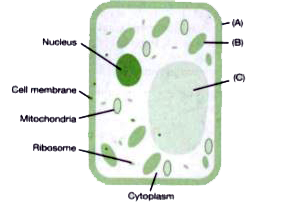Apical end of the cell of Euglenabears an invagination with three parts ____(a) , ____(b) , ____(c).
Cytostome (a) - Cytopharynx (b) - Reservoir (c)
Mouth (a) - Gullet (b) - Cytopharynx (c)
Stigma (a) - Cytostome (b) - Gullet (c)
Contractile (a) - Gullet (b) - Reservoir (c)
The correct Answer is:A
To answer the question regarding the apical end of the cell of Euglena and its invagination parts, we can break down the solution into the following steps:
1. Identify the Structure of Euglena:
- Euglena is a unicellular organism that has a distinct structure at its apical end, which includes an invagination that serves as the mouth.
2. Recognize the Three Parts:
- The invagination at the apical end of Euglena consists of three main parts:
- (a) Cytostome: This is the mouth opening of Euglena where food enters.
- (b) Cytopharynx: This is a tube-like structure that connects the cytostome to the reservoir and is involved in the passage of food.
- (c) Reservoir: This part stores excess food after it has been processed.
3. Confirm the Sequence:
- The correct sequence of the three parts is:
- (a) Cytostome
- (b) Cytopharynx
- (c) Reservoir
4. Final Answer:
- Therefore, the complete answer to the question is:
- (a) Cytostome, (b) Cytopharynx, (c) Reservoir.
- Euglena is a unicellular organism that has a distinct structure at its apical end, which includes an invagination that serves as the mouth.
- The invagination at the apical end of Euglena consists of three main parts:
- (a) Cytostome: This is the mouth opening of Euglena where food enters.
- (b) Cytopharynx: This is a tube-like structure that connects the cytostome to the reservoir and is involved in the passage of food.
- (c) Reservoir: This part stores excess food after it has been processed.
- The correct sequence of the three parts is:
- (a) Cytostome
- (b) Cytopharynx
- (c) Reservoir
- Therefore, the complete answer to the question is:
- (a) Cytostome, (b) Cytopharynx, (c) Reservoir.
Topper's Solved these Questions
Similar Questions
Knowledge Check
Load bearing parts of the part cells is
AMiddle lamellaBSecondary wallCPrimary wallDTertiary wallApical cell theory is applicable to
AAlgae, bryophytes and gymnospermsBAngiosperms onlyCPteriodphytes and angiospermsDAlgae, bryophytes and pteriodophytesIn the following you will find sentences, part of which are bold. Compare the bold part of each sentences with the expressions (a) ,(b) and (c) given below.Choose the expression which is an improvement upon the bold part. If none of the three expression improves the sentences, then your answer is (d).
By the end of this century, scientists surely have discovered a cure for cancer.Aare discoveringBwill have discoveredCmust discoverDno improvement
What are the three main parts of a cell ?
View SolutionIn a plant cell, cells are made up of different components enclosed in a membrane provide shape to plants and animals. Cell wall is the outer covering in the plant cell which provide shape and rigidity to the cell. Label the parts (A), (B), (C).

View Solution1. List three parts of nerve cell.
2. In which part of nerve cell, Nissl's granules present ? What is their composition ?
View SolutionExamine the figure given below and select the righ option giving all the three parts( a,b and c)

View SolutionDuring the formation of leaves and elongation of stem, some cells left behind from shoot apical meristem, constitute the ____________
View Solution
